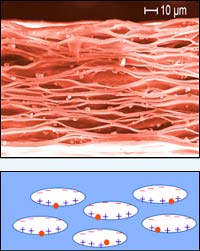Polymer Foams as Charge Carriers

Scanning electron microscope picture of a ferroelectretic foam, together with a graphical representation of the charging states in the pores. <br>
A research team in Austria has been unravelling the secrets of the charging of plastic foams. Its findings open the way for the development of flat microphones and loudspeakers, as well as “smart” surfaces that could be used as floor coverings, among other things. The interest in the success of the group´s work – which was co-funded by the Austrian Science Fund (FWF) – has resulted in the integration of the project in a European interdisciplinary research network.
During a thunder storm the electrical tension between the earth and the air is discharged by the lightning and hence lowered. In non-polar polymer foams a comparable process results in the precise opposite – an increase in the electrical charge. First, an electric discharge is induced in the microscopic voids (pores) in foamed plastics by applying an external voltage. The propagation of the discharge is then inhibited by the insulating properties of the polymer foam, resulting in charging of the pore walls. As the non-polar material is non-conductive, the charge is stored there. A team under Prof. Siegfried Bauer at the Johannes Kepler University Linz Institute for Experimental Physics has succeeded in proving the existence of this phenomenon. In so doing it has challenged established scientific doctrine which holds that such states can only exist in polar materials.
Pores with potential
The opposing positive and negative poles in the pores of the foam create an electrical potential. If the charged polymers are compressed, the gap between the two poles in the pore walls narrows, exciting an electrical signal. The transformation of pressure into an electrical signal that can be amplified and modulated enables polymers to be used as sensors, e.g. for “intelligent” floor coverings that “report” falls at senior citizens´ homes.
Changes in air pressure (acoustic oscillations) can also be converted into electrical signals in this way. As the polymers are easy to make and can be varied in many ways, they hold out the prospect for the development of inexpensive, high-quality flat microphones and loudspeakers. Identifying suitable materials was one of the aims of the project.
Nomen est omen
In the course of the project the team succeeded in describing an unexpected property of the plastic foams it was using: patterned charging is possible, and the polarity in the pores can thus be switched. As these are the first known materials to combine this property with an ability to store charges, Prof. Bauer created the new term “ferroelectret” to describe them. “What makes ferromagnets important is the fact that their polarity can be switched”, Bauer explained. “Materials that store charges are referred to as `electrets´. The term coined by us for these polymer foams refers to their ability to combine these two characteristics.”
Europe in the lead
The international significance of the ferroelectrets is reflected in the research collaborations in which the Linz group is involved. During the project cooperation agreements were concluded with universities in Darmstadt, Potsdam (Ger) and Tampere (Fi). “Today”, said Bauer, “we are part of a pan-European network that also includes a number of firms.” The global importance of this alliance will be reflected next October when ferroelectrets will be a topic at an international symposium held by America´s Institute of Electrical and Electronics Engineers (IEEE). The discovery and the team responsible for it will be the subject of an invited lecture. This recognition is proof of the global lead enjoyed by the project, and the new European network of experimental physicists, engineers and materials scientists that FWF funding helped establish.
Contact: Univ.-Prof. Dr. Siegfried Bauer, sbauer@jku.at, Tel. +43-732-2468-9241
Media Contact
More Information:
http://www.fwf.ac.at/en/press/tension.htmlAll latest news from the category: Materials Sciences
Materials management deals with the research, development, manufacturing and processing of raw and industrial materials. Key aspects here are biological and medical issues, which play an increasingly important role in this field.
innovations-report offers in-depth articles related to the development and application of materials and the structure and properties of new materials.
Newest articles

Silicon Carbide Innovation Alliance to drive industrial-scale semiconductor work
Known for its ability to withstand extreme environments and high voltages, silicon carbide (SiC) is a semiconducting material made up of silicon and carbon atoms arranged into crystals that is…

New SPECT/CT technique shows impressive biomarker identification
…offers increased access for prostate cancer patients. A novel SPECT/CT acquisition method can accurately detect radiopharmaceutical biodistribution in a convenient manner for prostate cancer patients, opening the door for more…

How 3D printers can give robots a soft touch
Soft skin coverings and touch sensors have emerged as a promising feature for robots that are both safer and more intuitive for human interaction, but they are expensive and difficult…





















